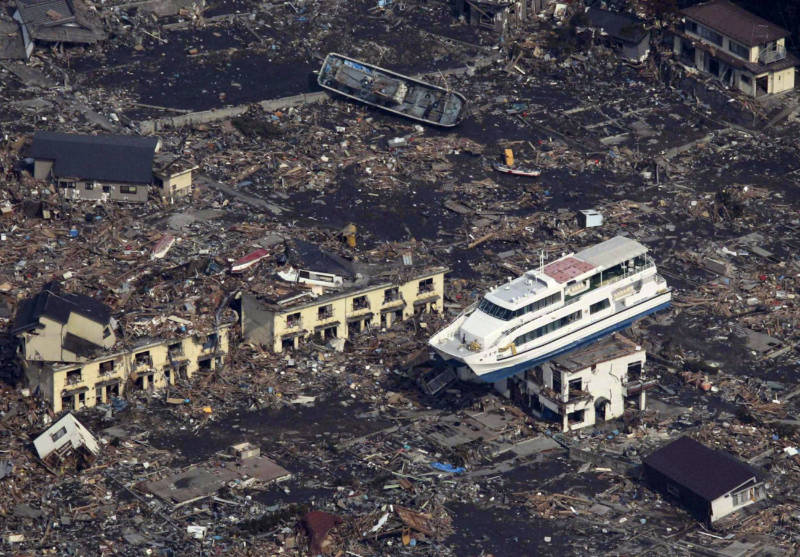The tsunami that crossed the Pacific Ocean from Japan was actually two huge waves that combined
Researchers have long suspected that tsunamis sometimes merge to create a single more powerful wave, but the tsunami caused by the earthquake that rocked Japan earlier this year was the first time they actually saw it happen.

The biggest earthquake ever recorded was in 1960, in Chile. The 9.5 quake killed and injured thousands there, and triggered a deadly tsunami that hit Hawaii, the Philippines, and Japan.
“It was a mystery for a long time,” said Tony Song, a research scientist at NASA’s Jet Propulsion Laboratory, of the resulting tsunami that crossed the Pacific. “How it happened so far away,” and caused so much damage.
The explanation, it turned out, was that it was a merging tsunami. When the quake hit, a wave radiated out from the epicenter. But it didn’t form a neat circle, like when you drop a stone into a pond. Instead, underwater mountains and ridges broke the wave into segments that headed in different directions. Then that mountainous underwater topography guided some of those sections back together. They merged into a single double-size wave that could cross the ocean without losing much steam.
The explanation made sense, but Song and other researchers had never seen it actually happen until the tsunami in March.
“We knew waves could merge, but had never seen evidence before,” said Song. This animation from NASA shows it happening. The wave radiates out from the earthquake’s epicenter. Then the animation zooms in to show the waves, which have been broken up, merging.
Scientists at NASA and Ohio State University lucked into the find. Three satellites capable of measuring sea level changes down to a matter of centimeters happened to be in the area. When they passed over the tsunami, two of them measured one height for the wave. A third, the NASA-Centre National d’Etudes Spaciales Jason-1 satellite, measured a different height, twice what the other satellites saw. It was a merging tsunami. The wave front the satellites measured was the one heading east from the earthquake’s epicenter, not the one that ravaged the Japanese coast. But the discovery at least raises the question of whether or not the wave going in the other direction, the one that did hit Japan, was also a merging tsunami. Song says, unfortunately, he doesn’t have the data to say one way or the other.
“Specifically, our study is about the double power away from Japan, instead of toward Japan, though the same mechanism might work in both directions.”
Merging tsunamis occasionally hit Crescent City, California. According to Song, the topography of the ocean floor has the same effect when earthquakes near Alaska trigger tsunamis headed for California.
Now that he’s observed one of these waves in action, Song says scientists will be able to make better forecasts, predicting where tsunami waves are likely to merge, and where they’re likely to hit land.
A couple of other items you may have missed over the last few months about the tsunami:
- It broke off icebergs in Antarctica.
- The earthquake shifted the sea floor the equivalent distance of half a football field and created a crack up to six feet wide in some places.
Song and his colleagues presented their analysis at the San Francisco meeting of the American Geophysical Union this week (#AGU11).
UPDATED and CORRECTED: An earlier version of this post may have misled some readers by implying that actual satellite data confirmed the merger of two tsunami waves into the front that hit Japan. The data was observed for waves moving in the opposite direction.
2 thoughts on “Wave Created by Japanese Earthquake was a “Merging Tsunami””
Comments are closed.

This is a good story; however, the headline is not correct. The superimposition of tsunami waves, as the text makes clear, was in the eastward-moving waves out in the Pacific. The west-moving waves that overwhelmed Japan were not merged. Many news sources made this same error.
Andrew, thanks for catching that and pointing it out. I checked with Dr. Song, and have updated and corrected the story.